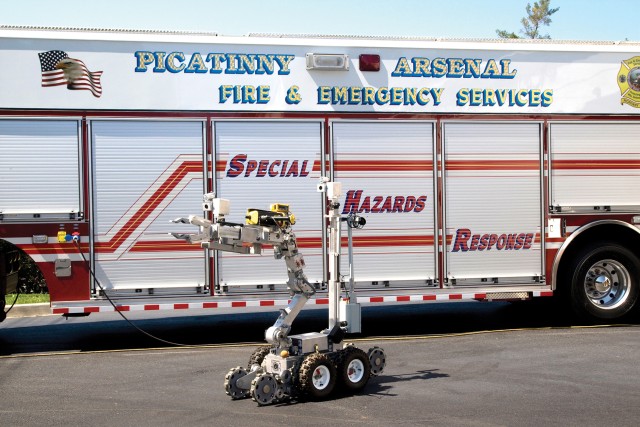PICATINNY ARSENAL, N.J. - Twelve Picatinny Arsenal and Five Parsippany District Five firefighters joined two New Jersey State Troopers here March 25 to train in radiation detection.
Participants in the training waved singing detection equipment near mannequins, vehicles and a variety of objects bearing low-levels of radioactive substances placed there by an instructor.
Their job was to identify the substances based on a "radiological signature," as indicated by the high-pitched instrument's displays. Had the training scenario been real, it would be critically important to determine the nature of the radioactive isotope. It could have been a legal situation, such as part of a medical procedure.
More ominously, the radioactive substance could have been obtained illegally and possibly be used to prepare a "dirty" radiation bomb, according to Michael Corr, who trained the firefighters under a contract with the Department of Energy.
The trainees demonstrated their use of the radiological equipment after attending a four-hour class earlier in the day.
As a protective measure, the firefighters wore dosimeters to ensure they would not receive hazardous radiation levels.
Firefighters learning to operate the radiological detection equipment also learned how to transmit data from the equipment to the Special Hazards Response Vehicle, which can further transmit the data to a unified command post.
Picatinny received the vehicle last year from Fort Monmouth, which is scheduled to close in September. This routing ability could make the raw data available to experts - however distant - whose speedy, detailed analysis would be very important to decision-makers during a crisis, said Picatinny Fire Chief Ronald Guidetti.
The new, 57-feet Special Hazards Response Vehicle with its 42-inch extended cab and store of specialized equipment is designed for response to chemical, biological, radiological, nuclear and explosive (CBRNE) incidents.
Learning to operate instruments that can detect and identify radioactive materials successfully was one task required in the "prepare" portion of the two-part radiological and nuclear counterterrorism training program.
Picatinny Fire Company Captain of Training Chris Barrella scheduled the training for the Picatinny firefighters because the radiological equipment came with the new vehicle.
Barella had also arranged for five Picatinny firefighters and five firefighters from Parsippany District Five to train in Nevada, where they received the "response" portion of the training.
To Rich Karlsson, Picatinny Director of Emergency Services, this combination of trained firefighters and advanced technological equipment raises the preparedness and responsiveness levels for any potential Picatinny disasters.
"You never know when you're going to get the call," he said.
Thanks to a host of mutual-aid agreements that exist between the many permanent and volunteer fire departments in the area, the new capabilities would extend to the whole region.
"If we were to get called by a local community, we would be able to detect and identify the materials and notify the appropriate authorities," said Guidetti.
With the well-publicized release of radiation after the earthquake and tsunami in Japan, Guidetti said that while the focus of the local training is on terrorist activities, it was timely to point out that the training and equipment can help in other types of radiological emergencies.




Social Sharing